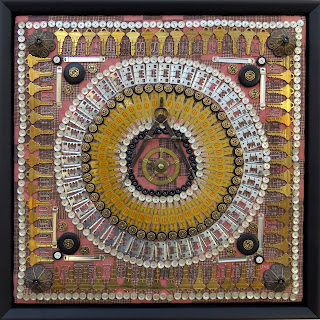(Above:
Mandala XXIV. Framed and hung as a diamond: 47 1/2" x 47 1/2"; as a square: 33 1/2" x 33 1/2". Found objects hand stitched to a corner of an old quilt. Objects include: Glass flower frog, aluminum cookie cutters, rivets, buttons, metal frame hanging devices, keys, clock gears, paper fasteners, a set of eight vintage cheese knives, a set of eight vintage metal coasters, red Tinkertoy sticks, vintage cocktail food picks, bread bag closures, and clip-on earring findings. Click on any image to enlarge.)
Many readers have expressed amazement at the number of multiples I have in my stash. I do admit having two buckets of old keys and more buttons than an average sewing shop, but I also have to admit that some of my stash is now feeling a dent. The boxes of two-hole brass buttons are getting low. Honestly, I never thought I could use them all but apparently this is happening. In fact, I am now actively looking for multiples of unusual (or even common!) things.
(Above: Me with
Mandala XXIV, sitting in front of my art quilt,
Second Marriage. This photo was taken to show size and scale. One of the things learned during the pandemic was how to best present artwork on-line ... as opposed to "proper" art images. Apparently, this is a good idea even though I hate being in front of the camera!)
Recently I went to two, local antique malls, Red Lion and Old Mill. I found several interesting items including the black coasters, aluminum cookie cutters, the set of cheese knives, more dominoes, and a container of 100 assorted cocktail picks. I also bought a Ziploc bag with 390 Tampa Nugget cigar bands. How do I know the correct number? Well, I spent quite a bit of time getting them laminated and cutting them out. (Three columns of 13 fit on one lamination folder. I filled ten!) They will be featured on an upcoming mandala.
(Above: Me holding
Mandala XXV on the left and
Mandala XXVI on the right).
Even before finishing Mandala XXIV, I was working on the two small pieces. Why? Well, when designing a large piece, there are objects that just don't work. Almost always, there's a better place on one of the small mandalas. Generally, I don't finish them all within a day of each other, but this week that happened.
(Above: Detail of
Mandala XXIV. For more details of this piece, just scroll further down.)
Every time I finish one of the large mandalas, a reader asks about the weight of the piece. It is assumed that "as a quilt" (especially an old, slightly damaged quilt like those I use), the artwork can't hang successfully due to the weight of the objects ... or at least, it can't hang for long before parts start sagging and/or fabric rips. Well, I solved potential disaster long before I stitched the first mandala.
(Above: Mandala XXIV, the back side.)
As a certified, professional picture framer, I am used to shadow-boxing all sorts of heavy items for wall-mounted display. It is important to distribute the weight. Each mandala has been stitched while stapled to a stretcher bar. It is then removed. A piece of acid-free foam-centered board is glued to the face of the stretcher bar. Then, the piece is re-stapled to the stretcher bar. Finally, I use buttonhole thread to stitch through the foam-centered board and the quilt. Running stitches are every two to three inches apart, both vertically and horizontally. In order to make sure the glass flower frog stay firmly in place, I used #3 perle cotton. This was the same thread originally used to stitch it to the quilt. By stitching a second stitch around the outer ring, the flower frog is now attached to both the quilt and the foam-centered board.
(Above:
Mandala XXV. Artwork: 10 1/2" x 10 1/2"; framed and hung as a diamond: 20 1/4" x 20 1/4"; hung as a square: 14 3/8" x 14 3/8". $225.)
The two small mandalas went together easily. Mandala XXV includes sewing machine bobbins, dominoes, keys, a clock gear, buttons, and hinges sent by a very nice reader!
(Above:
Mandala XXVI. Artwork: 10 1/2" x 10 1/2"; framed and hung as a diamond: 20 1/4" x 20 1/4"; hung as a square: 14 3/8" x 14 3/8". $225.)
Mandala XXVI includes a clock spring, keys, buttons, and zipper pulls sent by another reader plus plastic pull tabs sent from yet another, new friend. Believe it or not, the clip-on earring findings came from someone else! I'm very fortunate to have plenty of people adding to my stash! THANK YOU to each or you. I'm always happy to accept these strange things and try to incorporate them into my studio practice. For the things I can't use, I do my very best to place the items where they will get their "second life".
(Above and below: Detail images of
Mandala XXIV.)
Stuff can be mailed to me at Mouse House, Inc., 2123 Park Street, Columbia, SC. I know that by writing this here, I might be opening a can of worms ... but I'm up for the challenge!







































